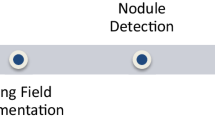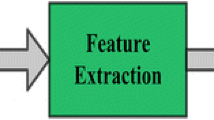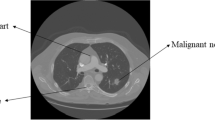Abstract
In this report, we are presenting our work on performance analyses of five different neural network classifiers viz. MLP, DL4JMLP, logistic regression, SGD and simple logistic classifier in lung nodule detection using WEKA interface. To the best of our knowledge, this report demonstrates first use of WEKA for comparative performance analyses of neural network classifiers in identifying lung nodules from lung CT-images. A total of 624 handcrafted features from 52 numbers of lung CT-images collected randomly from Lung Image Database Consortium (LIDC) were fed into WEKA to evaluate the performances of the classifiers under four different categories of computation. Performances of the classifiers were observed in terms of 11 important parameters viz. accuracy, kappa statistic, root mean squared error, TPR, FPR, precision, sensitivity, F-measurement, MCC, ROC area and PRC area. Results show 86.53%, 77.77%, 55.55%, 94.44% & 88.88% accuracy as well as 0.91, 0.86, 0.68, 0.91 & 0.93 ROC area for MLP, DL4JMLP, logistic, SGD and simple logistic classifier respectively at tenfold cross-validation by taking 66% of the data set for training and 34% for testing and validation purpose. SGDClassifier has been found the best performing followed by simple logistic classifier for the purpose.









Similar content being viewed by others
Data availability
Not applicable.
Code availability
Not applicable.
References
Zhang J, Xia Y, Cui H, Zhang Y (2018) Pulmonary nodule detection in medical images: a survey. Biomed Signal Process 43:138–147
Valente IRS, Cortez PC, Neto EC, Soares JM, de Albuquerque VHC, Tavares JMRS (2016) Automatic 3D pulmonary nodule detection in CT images: a survey. Comput Meth Prog Bio 124:91–107
Baldwin DR (2015) Prediction of risk of lung cancer in populations and in pulmonary nodules: significant progress to drive changes in paradigms. Lung Cancer 89:1–3
Cazzoli R, Buttitta F, Di Nicola M, Malatesta S, Marchetti A, Rom WN et al (2013) microRNAs derived from circulating exosomes as noninvasive biomarkers for screening and diagnosing lung cancer. J Thorac Oncol 8:1156–1162
Chen H, Zhang J, Xu Y, Chen B, Zhang K (2012) Performance comparison of artificial neural network and logistic regression model for differentiating lung nodules on CT scans. Expert Syst Appl 39:11503–11509
Polat H, Danaei MH (2019) Classification of pulmonary CT images by using hybrid 3D-deep convolutional neural network architecture. Appl Sci 9(5):940
Garfinkel L, Silverberg E (1991) Lung cancer and smoking trends in the United States over the past 25 years. CA Cancer J Clin 41:137–145
Aoyama M, Li Q, Katsuragawa S, Li F, Sone S, Doi K (2003) Computerized scheme for determination of the likelihood measure of malignancy for pulmonary nodules on low-dose CT images. Med Phys 30:387–394
Armato SG 3rd, Altman MB, Wilkie J, Sone S, Li F, Doi K et al (2003) Automated lung nodule classification following automated nodule detection on CT: a serial approach. Med Phys 30:1188–1197
Awai K, Murao K, Ozawa A, Nakayama Y, Nakaura T, Liu D et al (2006) Pulmonary nodules: estimation of malignancy at thin-section helical CT–effect of computer-aided diagnosis on performance of radiologists. Radiology 239:276–284
Lee JW, Goo JM, Lee HJ, Kim JH, Kim S, Kim YT (2004) The potential contribution of a computer-aided detection system for lung nodule detection in multidetector row computed tomography. Invest Radiol 39:649–655
Shah SK, McNitt-Gray MF, Rogers SR, Goldin JG, Suh RD, Sayre JW et al (2005) Computer aided characterization of the solitary pulmonary nodule using volumetric and contrast enhancement features. Acad Radiol 12:1310–1319
Shah SK, McNitt-Gray MF, Rogers SR, Goldin JG, Suh RD, Sayre JW et al (2005) Computer-aided diagnosis of the solitary pulmonary nodule. Acad Radiol 12:570–575
Huang W, Xue Y, Wu Y (2019) A CAD system for pulmonary nodule prediction based on deep three-dimensional convolutional neural networks and ensemble learning. PLoS ONE 14(7):e0219369
Shi Z, Hao H, Zhao M, Feng Y, He L, Wang Y et al (2019) A deep CNN based transfer learning method for false positive reduction. Multimed Tools Appl 78:1017–1033
Tan M, Deklerck R, Jansen B, Bister M, Cornelis J (2011) A novel computer-aided lung nodule detection system for CT images. Med Phys 38:5630–5645
Gupta A, Saar T, Martens O, Moullec YL (2018) Automatic detection of multisize pulmonary nodules in CT images: large-scale validation of the false-positive reduction step. Med Phys 45:1135–1149
Jiang H, Ma H, Qian W, Gao M, Li Y, Hongyang J et al (2018) An automatic detection system of lung nodule based on multigroup patch-based deep learning network. IEEE J Biomed Health Inform 22:1227–1237
Javaid M, Javid M, Rehman MZ, Shah SI (2016) A novel approach to CAD system for the detection of lung nodules in CT images. Comput Methods Progr Biomed 135:125–139
Wang Z, Xin J, Sun P, Lin Z, Yao Y, Gao X (2018) Improved lung nodule diagnosis accuracy using lung CT images with uncertain class. Comput Meth Prog Bio 162:197–209
Tammemagi M, Ritchie AJ, Atkar-Khattra S, Dougherty B, Sanghera C, Mayo JR et al (2019) Predicting malignancy risk of screen-detected lung nodules-mean diameter or volume. J Thorac Oncol 14:203–211
Silva AC, de Paiva AC, de Oliveira ACM (2005) Comparison of FLDA, MLP and SVM in Diagnosis of Lung Nodule. In: Perner P, Imiya A (eds) Machine Learning and Data Mining in Pattern Recognition. Springer, Berlin
Mbiki S, McClendon J, Alexander-Bryant A, Gilmore J (2020) Classifying changes in LN-18 glial cell morphology: a supervised machine learning approach to analyzing cell microscopy data via FIJI and WEKA. Med Biol Eng Comput 58:1419–1430
Somasundaram E, Deaton J, Kaufman R, Brady S (2018) Fully automated tissue classifier for contrast-enhanced CT scans of adult and pediatric patients. Phys Med Biol 63:135009
Yadav AK, Chandel SS (2015) Solar energy potential assessment of Western Himalayan Indian state of Himachal Pradesh using J48 algorithm of WEKA in ANN based prediction model. Renew Energ 75:675–693
Yadav AK, Malik H, Chandel SS (2014) Selection of most relevant input parameters using WEKA for artificial neural network based solar radiation prediction models. Renew Sustain Energy Rev 31:509–519
Hussain M, Gogoi L (2021) Feature based analyses of lung nodules from computed tomography (CT) images. IOP Conf Ser 1020:012007
https://wiki.cancerimagingarchive.net/display/Public/LIDC-IDRI.
McNitt-Gray MF, Armato SG 3rd, Meyer CR, Reeves AP, McLennan G, Pais RC et al (2007) The lung image database consortium (LIDC) data collection process for nodule detection and annotation. Acad Radiol 14:1464–1474
Armato SG 3rd, McLennan G, McNitt-Gray MF, Meyer CR, Yankelevitz D, Aberle DR et al (2004) Lung image database consortium: developing a resource for the medical imaging research community. Radiology 232:739–748
Witten IH, Frank E, Hall MA, Pal CJ (2016) Data Mining: Practical Machine Learning Tools and Techniques, 4th edn. Morgan Kaufmann Publishers, Burlington
Mohamed MR, Nasr AA, Tarrad IF, Abdulmageed SR (2019) Exploiting incremental classifiers for the training of an adaptive intrusion detection model. Int J Netw Secur 21:275–289
Debnath P, Chittora P, Chakrabarti T, Chakrabarti P, Leonowicz Z, Jasinski M et al (2021) Analysis of earthquake forecasting in india using supervised machine learning classifiers. Sustainability 13(2):971
Gutiérrez PA, Hervás-Martínez C, Martínez-Estudillo FJ (2011) Logistic regression by means of evolutionary radial basis function neural networks. IEEE T Neural Networ 22:246–263
Landwehr N, Hall M, Frank E (2005) Logistic model trees. Mach Learn 59:161–205
Mandrekar JN (2010) Receiver operating characteristic curve in diagnostic test assessment. J Thorac Oncol 5:1315–1316
Morales SN, Martínez LR, Gómez JAH, López RR, Torres-Argüelles V (2019) Predictors of organizational resilience by factorial analysis. Int J Eng Bus 11:1–13
Funding
DST,India,IF 180853,Lakshipriya Gogoi
Author information
Authors and Affiliations
Corresponding author
Ethics declarations
Conflict of interest
There is no known conflicts of interest.
Ethical approval
Not applicable.
Additional information
Publisher's Note
Springer Nature remains neutral with regard to jurisdictional claims in published maps and institutional affiliations.
Supplementary Information
Below is the link to the electronic supplementary material.
Rights and permissions
Springer Nature or its licensor (e.g. a society or other partner) holds exclusive rights to this article under a publishing agreement with the author(s) or other rightsholder(s); author self-archiving of the accepted manuscript version of this article is solely governed by the terms of such publishing agreement and applicable law.
About this article
Cite this article
Hussain, M.A., Gogoi, L. Performance analyses of five neural network classifiers on nodule classification in lung CT images using WEKA: a comparative study. Phys Eng Sci Med 45, 1193–1204 (2022). https://doi.org/10.1007/s13246-022-01187-3
Received:
Accepted:
Published:
Issue Date:
DOI: https://doi.org/10.1007/s13246-022-01187-3




